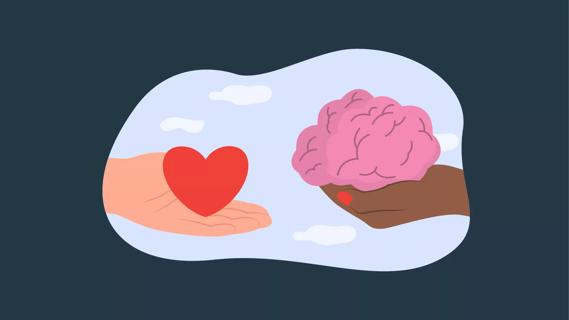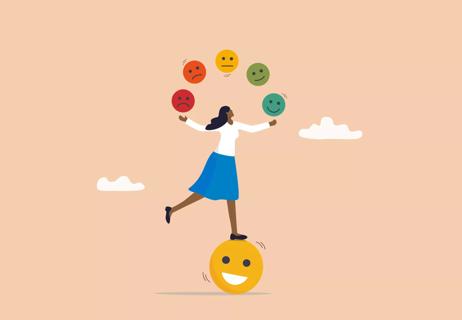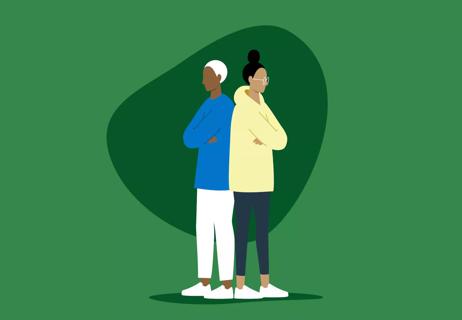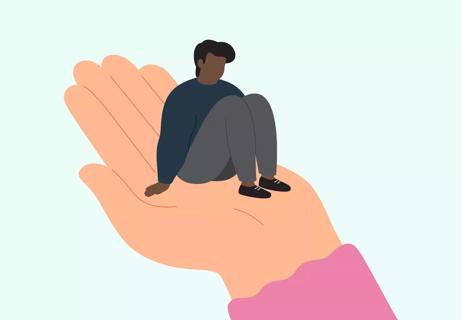Feeling another person’s embarrassment is normal, but you can process it healthily

Sometimes, it’s nice to live vicariously through other people’s experiences. When good things happen to those we care about, we may feel a flurry of excitement and emotion that mirrors their reaction.
Advertisement
Cleveland Clinic is a non-profit academic medical center. Advertising on our site helps support our mission. We do not endorse non-Cleveland Clinic products or services. Policy
But when something embarrassing or cringe-worthy happens to someone else — even if you don’t know them at all — you can end up experiencing second-hand embarrassment (also known as vicarious embarrassment) — and that, unfortunately, comes with all the weird and quirky symptoms associated with being embarrassed.
So, how common is second-hand embarrassment and can you stop it from happening to you? Clinical health psychologist Marielle Collins, PhD, explains what’s really going on, along with ways to recover from the more extreme circumstances.
Second-hand or vicarious embarrassment is when you personally experience embarrassment, discomfort, shame or guilt whenever you witness someone else have an experience that’s particularly embarrassing or causes them to be viewed negatively.
For example, maybe you see someone walking down the street holding a coffee in one hand and texting someone else on their cell phone in the other. Next thing you know, they trip, take a fall and spill their coffee everywhere.
“Even though you weren’t part of making that person trip and you weren’t the one who fell, you can still feel the emotion that they’re probably feeling,” says Dr. Collins.
As someone rushes to help the person who fell, maybe your facial expression cringes a bit. You start to feel hot, get goosebumps on your arms or become a little short of breath, and you shy away from looking at the person who fell. Maybe you even instinctually laugh because if you had been the one to fall, maybe you’d laugh it off awkwardly so people pay no mind and move on.
Advertisement
“A lot of times, these feelings can come with anxiety and a fear of negative social evaluation,” says Dr. Collins. “Anxiety can be distressing and may get in the way of whatever you’re doing in the moment.”
If someone does something particularly embarrassing on a Zoom® call or Microsoft Teams® meeting — like leaving their mic unmuted so everyone can hear what they’re saying — you could wind up distracted or hyper-focusing on the embarrassing thing that’s happening because you just want to make it stop. You might even end up cringing or laughing on camera, which isn’t something you want to happen in a professional setting.
“Vicarious embarrassment can add to the stress of a virtual meeting, especially if you already struggle with an anxiety disorder,” notes Dr. Collins. “Witnessing someone else experience embarrassment could increase anxious thoughts about whether a similar experience could happen to you and activate your body’s stress response.”
Because of our brain power, we’re consciously self-aware about how we’re perceived as we navigate through the world around us. Regions of our brains are responsible for our ability to regulate our emotions, responding to pain and allowing our bodies to heal. Those same parts of our brain that are activated when we personally experience pain, shame or regret are also activated when we see others experience those things for themselves.
“That’s the concept of empathy,” Dr. Collins explains. “Our brains are wired to be able to simulate the emotional experiences of other people and feel what another person is feeling.”
This is why we cry when we see someone grieving or in pain and why we cringe or react a certain way when something embarrassing happens to someone else. In fact, some research suggests that we feel pained when someone else experiences pain because of our own heightened anxiety and level of distress. And while we experience higher levels of second-hand embarrassment when something happens to someone we’re socially close with, it can also happen when we’re watching reality TV (where embarrassing situations are often reoccurring).
“You might be more likely to have second-hand embarrassment if you have a high capacity for empathy,” states Dr. Collins. “When we think of empathy, we tend to think of having a shared emotional sense with someone where we’re feeling the same pain as them. But the thing with vicarious embarrassment is it can also happen when the person themselves isn’t embarrassed in that moment.”
For example, you might cringe or feel anxious if you see someone walking around with toilet paper stuck to their shoe or a stain on their shirt they haven’t yet noticed. This happens because your brain is perceiving how they might respond and you’re mentalizing that unfelt emotion they may have when they discover that embarrassing toilet paper or stain.
Advertisement
So, how do you deal with second-hand embarrassment? It can be particularly tricky, as it comes on so suddenly. But there are things you can do to reduce its effects and decrease the likelihood of it lingering.
If you’re experiencing second-hand embarrassment, you should embrace your ability to have empathy with others. After all, human emotion, and the ability to put ourselves in other people’s shoes, makes you human.
“Sometimes, reframing the way you think about emotions can be helpful,” says Dr. Collins. “When we experience emotions that are uncomfortable, we often think they are ‘bad’, and that makes us even more anxious as we try to get rid of it, increasing distress. It can help to have a more mindful approach by acknowledging how we are feeling in the moment without judgment and allowing the emotion to pass.”
Dr. Collins often relies on this acronym to help address any distressing emotion or intense emotion you might be feeling before it overwhelms you.
“If you notice you’re experiencing second-hand embarrassment, instead of judging yourself for it or reacting to it, you might want to pause in that moment and use the STOP technique,” says Dr. Collins.
Here’s how it works:
“When we go down a rabbit hole with our thoughts and emotions, it can all end up being amplified,” she continues. “This STOP technique helps you move in a more helpful direction by pausing for a minute to stop whatever stream of thought you’re having.”
Advertisement
Focusing on your breath is helpful for two reasons. One, when you slow your breathing, you activate your parasympathetic nervous system (which is responsible for relaxing your body after periods of stress and danger) and simultaneously slow your heart rate. And two, it also gives you something neutral to focus your attention on.
“If you’re focused on something embarrassing and you keep thinking about it, stress and anxiety are likely going to increase,” says Dr. Collins. “But if you focus on your breath, you can calm your body and anchor your mind in the present moment on something neutral.”
This step requires that you carve out a judge-free zone for yourself. By taking note of how you’re feeling physically and mentally without attaching any shame or guilt to that feeling, this serves as a sort of internal checkpoint.
“The more we can be curious about our emotional experiences instead of wanting to change them, make them different or get rid of them, the more we can ground ourselves in the present moment,” explains Dr. Collins. “You might ask yourself, ‘How do I know that I’m anxious?’ ‘What do I notice in my body?’ Emotions don’t have to be good or bad. They’re all part of the full experience of what it means to be human.”
Advertisement
Once you identify how you’re feeling and you’ve had that time to think about it, ask yourself one question: What can you do next that will be helpful to you and other people involved?
“This might look like self-care, distracting yourself from the situation, stepping away and going for a walk, or switching your focus,” says Dr. Collins. “This is about identifying whatever you need in the moment.”
If someone’s noticed your reaction to their embarrassing moment, or attention has been redirected toward your response because of how you responded, it’s important to ask them how they’re feeling, offer possible support and apologize while providing clarity for why you responded or reacted the way that you did. By doing this, you can minimize conflict and reduce the chances of further hurting someone else’s feelings.
“We all have automatic responses that don’t necessarily represent how we feel,” shares Dr. Collins. “If you’re going to have an open conversation about a seemingly negative reaction you had, start by asking them about how they’re feeling and use that same capacity for empathy to listen and validate their experience before clarifying your reaction.”
At the end of it all, it’s important to recognize that we’re all human, that we can normalize our emotions and behaviors — including embarrassment — and that we can respond to such situations in an empathetic and judgment-free way.
“We feel what we feel, and when we judge ourselves for feeling a certain way, it tends to make everything worse,” says Dr. Collins. “Trying to be mindful, curious and observe is good, but harboring guilt and shame doesn’t help anyone.”
Learn more about our editorial process.
Advertisement

The higher your EQ, the more in touch you are with your feelings, as well as other people’s

Enjoyment, sadness, disgust, fear and anger are just the beginning of your emotions

Follow the ’problem, feeling, ask‘ technique to communicate clearly and effectively

It’s a feeling we all have, but it’s important not to let it take over your relationships

When you’re deeply sensitive to certain physical, emotional or social situations

Most recommended precautions center around minimizing bruising or swelling

Even one drink can have an impact on your cognitive function leading to slurred speech, blurred vision and impaired memory

Type 2 diabetes isn’t inevitable with these dietary changes

Applying a hot or cold compress can help with pain